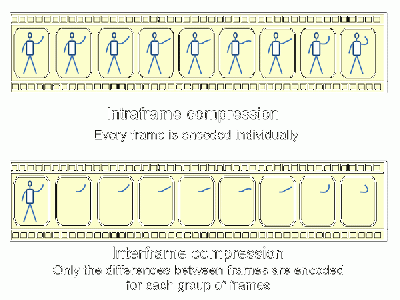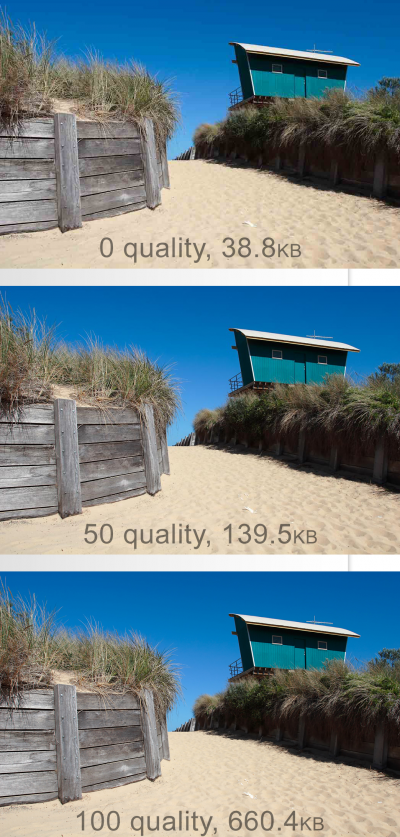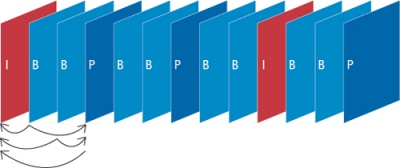Prototyping 2013-11-05 (Lens Based Media): Difference between revisions
| (31 intermediate revisions by the same user not shown) | |||
| Line 1: | Line 1: | ||
= Compression & Codecs = | = Compression & Codecs in video = | ||
(File)'''Format''' or Container is the shipping box, '''codec''' is the goods inside the box. | |||
== | == Format == | ||
* determines the way audio and video streams (and other metadata(like the codec info)) are stored inside the file | |||
* Examples are : | |||
** .avi (Microsoft -> OLD) | |||
** .wmf (Microsoft -> Unflexible) | |||
** .mov (Apple -> supports a lot of codecs) | |||
** .ogg (Open Source -> but not very well supported by editing software) | |||
** .mkv (Open Source -> but not very well supported by editing software) | |||
** .mp4 (works on virtually all platforms, browsers etc) | |||
[[file:interframe.gif|400px|right|thumb|intra- vs. interframe compression]] | |||
=== Data moshing | == Encoding/Compressing == | ||
'''Why do we compress?''' | |||
* Image- and videofile sizes reduced | |||
* More files to store, or longer videos | |||
* Faster to download | |||
* Downside: someone has to decode! | |||
[[File:jpegcompression.png|thumb|right|400px|jpeg compression]] | |||
<br /> | |||
===Types of compression'=== | |||
* '''Intraframe''' or spatial compression | |||
** Compresses each frame (so similar to image compression, with for instance JPG) | |||
** No effective size compression | |||
** High Quality | |||
** Easily readable by edit software | |||
** Apple ProRes, DNxHD (Avid) | |||
* '''Interframe''' or temporal Compression | |||
** Compress BETWEEN frames | |||
** effective size compression | |||
** Not easy for edit software | |||
** Use for sharing -> final output | |||
** MPEG-2 (DVD's, hardware players), DivX (downloads), H264 (currently has best quality vs. file ratio) | |||
<br> | |||
[http://en.wikipedia.org/wiki/Comparison_of_video_codecs comparison of video codec] | |||
=== encoding techniques === | |||
* Run length encoding > Looks for identical segments (often lossless) | |||
* [http://www.popmodernism.org/appropirate/delta.html Transform coding] > Most used (jpeg, DCT, wavelet) (selectively removes ‘non-relevant’ detail from the image). | |||
* [http://www.knotless.com/1/post/2012/07/the-mysteries-of-chroma-sub-sampling.html Chroma subsampling] >Selective loss of resolution (4:4:4 vs 4:2:0) | |||
* Reducing bit-depth (reducing colour accuracy) | |||
* Fractal compression (replacing pixels with mathematic approximations) | |||
[[file:iframes.jpg|400px]] | |||
[http://www.axis.com/products/video/about_networkvideo/compression.htm More Info]<br/> | |||
[http://www.youtube.com/watch?v=ShG1mnHKntg&t=2m2s] <br/> | |||
== Encoding Tools == | |||
* [http://www.ffmpeg.org/download.html ffmpeg (ffmpegX for a Mac gui version)] | |||
* [http://en.wikipedia.org/wiki/MEncoder Mencoder] | |||
* [http://handbrake.fr/ Handbrake] | |||
* [http://www.squared5.com/ Mpegstreamclip] | |||
* Adobe Media Encoder | |||
== Bitrate + Framesize == | |||
Most lossy codecs allow you to set a [http://neuron2.net/LVG/ratesandsizes.html bitrate] (the amount of bits per second) | |||
<br>Together with the framesize this determines the quality of the video. | |||
[http://floppyfilms.pleintekst.nl/oscars_2009/slumdog/ Floppy Films] | |||
== Workflow, Archiving & Delivery == | |||
There's no solution to the question 'What is the best setting for my video?". All depends on the platform you will deliver to! | |||
* How do you record? (Camera codec? DSLR) | |||
* How do you edit? (intermediate files?) | |||
* What do you deliver? (Archiving, uploading, DVD?) | |||
<br > | |||
Example, '''for editing/archiving use''': | |||
* ProRes video codec (visually lossless through many iterations) | |||
* Wav/Aiff audio codec | |||
* .mov container | |||
'''For (online) delivery use''': | |||
* H.264 codec | |||
* MP3/ACC audio codec | |||
* .mp4 container | |||
<br> | |||
* [http://mashable.com/2010/06/03/youtube-i-am-sitting/ what happens when you upload to youtube?] | |||
== Glitch Art & Data moshing == | |||
[[File:downloadfinished.jpg|right|thumb|400px|Download Finished]] | [[File:downloadfinished.jpg|right|thumb|400px|Download Finished]] | ||
* [http://www.youtube.com/watch?v=tYytVzbPky8 | * [http://www.youtube.com/watch?v=tYytVzbPky8 How to datamosh] | ||
* [http://www.download-finished.com/ | * [http://www.download-finished.com/ Download Finished] by [http://wwwwwwwwwwwwwwwwwwwwww.bitnik.org/d/| Mediengruppe Bitnik] | ||
* [http://snorpey.github.io/jpg-glitch/ | * [http://snorpey.github.io/jpg-glitch/ glitch your image, source code] | ||
{{#ev:youtube|mvqakws0CeU?version=3&autohide=1&showinfo=0}} | {{#ev:youtube|mvqakws0CeU?version=3&autohide=1&showinfo=0}} | ||
Latest revision as of 10:43, 5 November 2013
Compression & Codecs in video
(File)Format or Container is the shipping box, codec is the goods inside the box.
Format
- determines the way audio and video streams (and other metadata(like the codec info)) are stored inside the file
- Examples are :
- .avi (Microsoft -> OLD)
- .wmf (Microsoft -> Unflexible)
- .mov (Apple -> supports a lot of codecs)
- .ogg (Open Source -> but not very well supported by editing software)
- .mkv (Open Source -> but not very well supported by editing software)
- .mp4 (works on virtually all platforms, browsers etc)
Encoding/Compressing
Why do we compress?
- Image- and videofile sizes reduced
- More files to store, or longer videos
- Faster to download
- Downside: someone has to decode!
Types of compression'
- Intraframe or spatial compression
- Compresses each frame (so similar to image compression, with for instance JPG)
- No effective size compression
- High Quality
- Easily readable by edit software
- Apple ProRes, DNxHD (Avid)
- Interframe or temporal Compression
- Compress BETWEEN frames
- effective size compression
- Not easy for edit software
- Use for sharing -> final output
- MPEG-2 (DVD's, hardware players), DivX (downloads), H264 (currently has best quality vs. file ratio)
encoding techniques
- Run length encoding > Looks for identical segments (often lossless)
- Transform coding > Most used (jpeg, DCT, wavelet) (selectively removes ‘non-relevant’ detail from the image).
- Chroma subsampling >Selective loss of resolution (4:4:4 vs 4:2:0)
- Reducing bit-depth (reducing colour accuracy)
- Fractal compression (replacing pixels with mathematic approximations)
Encoding Tools
- ffmpeg (ffmpegX for a Mac gui version)
- Mencoder
- Handbrake
- Mpegstreamclip
- Adobe Media Encoder
Bitrate + Framesize
Most lossy codecs allow you to set a bitrate (the amount of bits per second)
Together with the framesize this determines the quality of the video.
Floppy Films
Workflow, Archiving & Delivery
There's no solution to the question 'What is the best setting for my video?". All depends on the platform you will deliver to!
- How do you record? (Camera codec? DSLR)
- How do you edit? (intermediate files?)
- What do you deliver? (Archiving, uploading, DVD?)
Example, for editing/archiving use:
- ProRes video codec (visually lossless through many iterations)
- Wav/Aiff audio codec
- .mov container
For (online) delivery use:
- H.264 codec
- MP3/ACC audio codec
- .mp4 container
Glitch Art & Data moshing
{{#ev:youtube|mvqakws0CeU?version=3&autohide=1&showinfo=0}}




